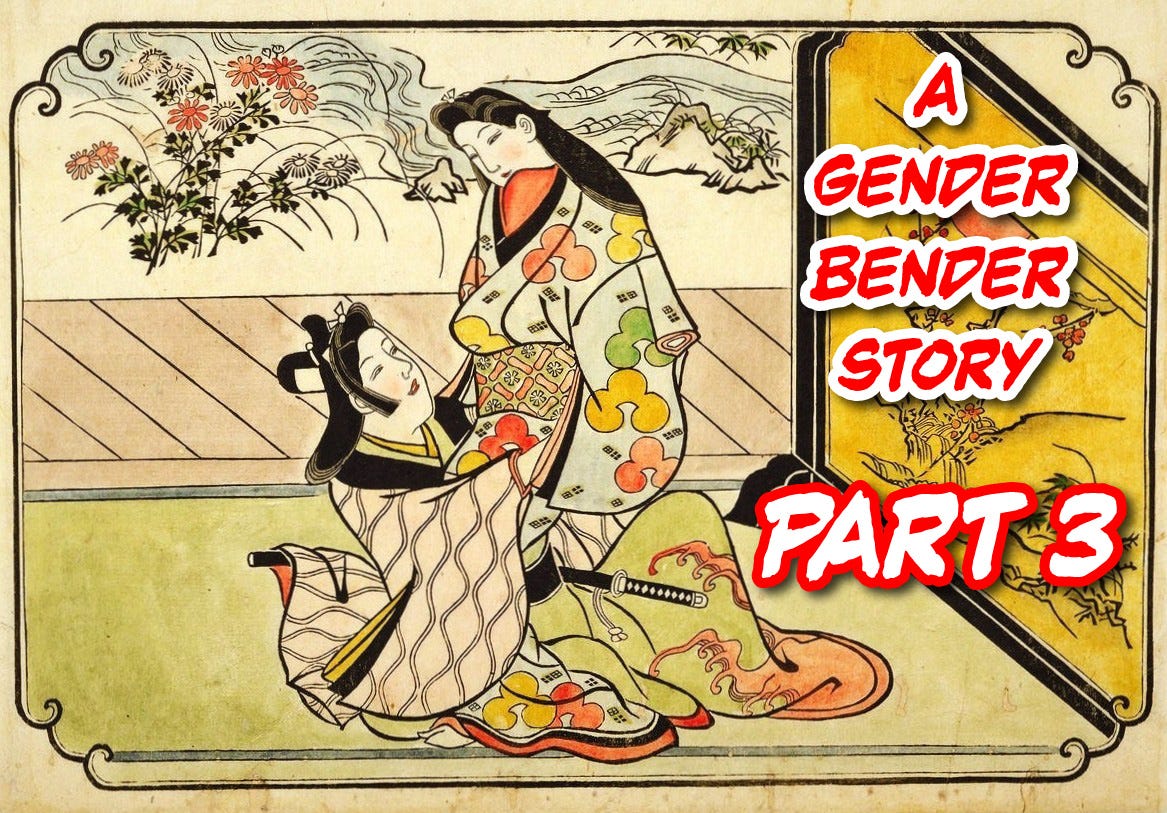Torikaebaya Monogatari: The Epic, Raunchy Gender Bending Story of Early Japan (Part 3)

Just when you thought Saishō couldn’t possibly be more of an ass…
If you haven’t read Part 2, click here.
Saishō now decides to concentrate on getting into Wakagimi’s kimono—though he still has not met or even seen her from afar. He goes to her and gets turned down hard. This makes him all weepy, because underneath his villainous exterior he’s a tender soul.
He goes to find his buddy Himegimi for some bro talk about how girls are all the same, but when he sees his friend, Saishō notices that Himegimi is looking particularly lovely for a boy that night, so Saishō attempts to force himself upon Himegimi while still thinking Himegimi’s a man. (Looks like that tender soul could not escape from the villainous exterior.)
Saishō is shocked to discover that Himegimi has lady parts, proceeds to impregnate her, and practically abducts her for good measure. There’s a lot of “it [is] customary [...] for the woman to submit to whatever inconveniences a man creates, no matter how wrong they may be” and “it’s most unnatural for you to disguise yourself as a man” going on here, with both Saishō and the narrator piling it on.
Himegimi is so charmed by Saishō’s thoughtful gaslighting and by her adorable new foetus that she starts dressing and acting like a woman. While she’s busy sitting around the house with an enormous belly being sick every morning, Saishō is being a compassionate lover and getting Yon no Kimi pregnant again. Himegimi eventually gives birth to a son.
To cause emotional whiplash in the modern reader, a lot of this is told in beautiful poems.
Meanwhile, Wakagimi is worried about Himegimi’s disappearance. Naturally, he can’t leave the palace dressed as a woman—that would be most improper. So Wakagimi dresses as a man and goes off looking for Himegimi. First stop is the mystical mountain where the prince with a China fetish lives. On the way, Wakagimi passes through the place where Himegimi is still living with Saishō, and there’s some hemming and hawing and confusion, and they just miss meeting each other.
Wakagimi’s visit to the prince is hella confusing: Wakagimi was born a man, but lives like a woman, but is disguised as a man right now. At first the prince sees Wakagimi as a woman, because he’s only moderately mystical and wise: he sees through at most one layer of disguise. There’s a hilariously laconic “oh, BTW, I was born a boy” conversation where the prince responds with something akin to “yeah, that happens, also your sister will make a great Empress.”
Himegimi and Wakagimi eventually “come to their senses” and decide to fully swap back to their birth genders by taking over each other’s lives. The reader is treated to a tengu ex machina: the earlier gender confusion gets blamed on a tengu (天狗), a type of evil spirit. They tell their father they’re going to swap, and he is relieved that his boomer ideas are vindicated.
Himegimi leaves Saishō’s cozy countryside brainwashing facility and spends some time with Wakagimi on the mystical mountain exchanging knowledge for the big swap. Wakagimi takes the opportunity to fall in love with the older princess.
Tune in next week for the finale to find out how things resolve after the Sailor Moon transformation sequence in which those crazy *gimis swap costumes and roles!
References
Pflugfelder, Gregory M. “Strange fates. Sex, gender, and sexuality in Torikaebaya Monogatari.” Monumenta Nipponica, Vol. 47, No. 3 (Autumn 1992), pp. 347–368. http://www.jstor.org/stable/2385103
Willig, Rosette F. (translator). The Changelings: a classical Japanese court tale. Stanford UP, 1983.


The ancients really can't stop making us cringe.